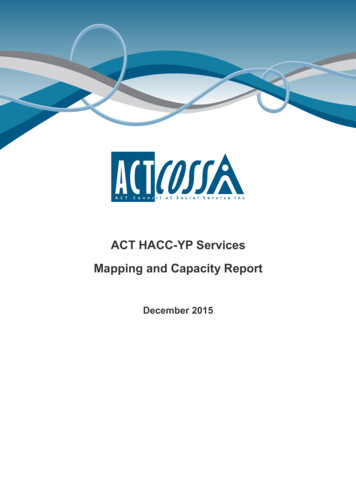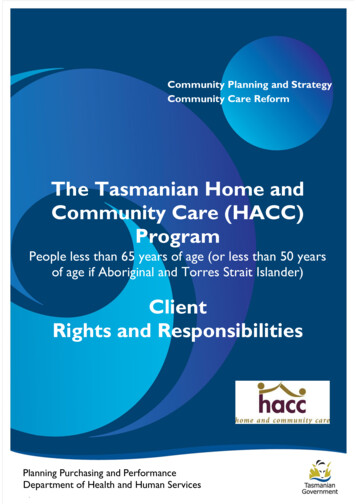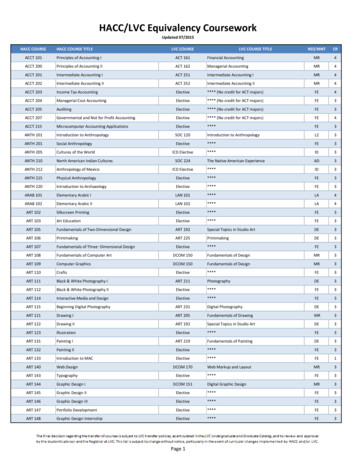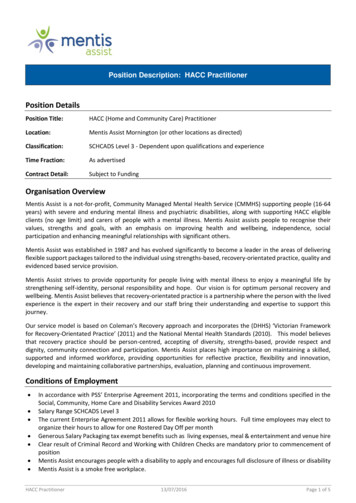
Transcription
ACT HACC-YP ServicesMapping and Capacity ReportDecember 2015
About ACTCOSSACTCOSS acknowledges Canberra has been built on the land of the Ngunnawal people. Wepay respects to their Elders and recognise the strength and resilience of Aboriginal and TorresStrait Islander peoples. We celebrate Aboriginal and Torres Strait Islander cultures and ongoingcontributions to the ACT community.The ACT Council of Social Service Inc. (ACTCOSS) is the peak representative body for not-forprofit community organisations, people living with disadvantage and low-income citizens of theTerritory.ACTCOSS is a member of the nationwide COSS network, made up of each of the state andterritory Councils and the national body, the Australian Council of Social Service (ACOSS).ACTCOSS’ vision is to live in a fair and equitable community that respects and values diversity,human rights and sustainability and promotes justice, equity, reconciliation and social inclusion.The membership of the Council includes the majority of community based service providers inthe social welfare area, a range of community associations and networks, self-help andconsumer groups and interested individuals.ACTCOSS receives funding from the ACT Government.ACTCOSS advises that this document may be publicly distributed, including by placing a copyon our website.AcknowledgementsMany thanks to all the dedicated staff at ACT HACC-YP Services for their time and efforts incontributing to this research.Contact DetailsPhone:Fax:Address:Email:Web:02 6202 720002 6288 0070Weston Community Hub, 1/6 Gritten St, Weston ACT or:Deputy Director:Policy Officer:Susan HelyarWendy ProwseTara PrinceDecember 2015ISBN 978-1-876632-24-3 (electronic version) Copyright ACT Council of Social Service IncorporatedThis publication is copyright, apart from use by those agencies for which it has been produced.Non-profit associations and groups have permission to reproduce parts of this publication aslong as the original meaning is retained and proper credit is given to the ACT Council of SocialService Inc (ACTCOSS). All other individuals and Agencies seeking to reproduce material fromthis publication should obtain the permission of the Director of ACTCOSS.2
Table of ContentsAcknowledgements . 2Acronyms . 4Executive Summary . 5Part 1: Introduction . 81.1 Background . 81.2 The ACT HACC-YP Unmet Need Survey . 91.3 The ACT HACC-YP Organisation Survey . 9Part 2: Features of the Existing ACT HACC-YP Service System . 112.1 Overview of HACC-YP Services Funded in the ACT . 112.2 HACC-YP Service Types in the ACT by Number of Providers Funded. 112.3 HACC-YP Funded Organisations in the ACT by Number of ServiceTypes . 132.4 Geographic Coverage of HACC-YP Service Types by Number andPercentage of Services that Cover Each Region . 142.5 Geographic Coverage of HACC-YP Service Types by Number ofRegions each HACC-YP Service covers . 15Part 3: Unmet Need and Capacity Issues . 163.1 HACC-YP Unmet Need Survey Findings . 163.2 HACC-YP Organisation Survey Findings: Amount of HACC-YPFunded Support Provided and Related Capacity Issues. 193.3 Summary. 23Part 4: Impacts of Inadequate or No Support on People with Disability . 244.1 Deteriorating Health and Wellbeing . 244.2 Housing Issues . 254.3 Family and Carer Stress and Deteriorating Health. 26Part 5: Impacts of Capacity Issues on Service Providers . 275.1 Utilising Other Sources of Funding . 275.2 Workforce Changes/Restructure . 275.3 Increasing Client Fees/Costs . 275.4 Prioritising Access. 285.5 Changing/Restructuring Service Operations . 28Part 6: Conclusion and Recommendations . 29Appendices . 313
AcronymsACTCOSSACT Council of Social ServiceHACC-YPHome and Community Care-Younger PeopleNDIANational Disability Insurance AgencyNDISNational Disability Insurance Scheme4
Executive SummaryACT Home and Community Care-Younger People (HACC-YP) Services forpeople with an ongoing disability under 65 years, have had capacity issues forover 18 months, with many people not able to access a service they need. Thisproject aimed to map the existing ACT HACC-YP Service System and assesscapacity and unmet need. This is in the context of the ACT HACC-YP Programundergoing a review, with current contracts ending June 2016.Two surveys were developed, collated and analysed: ‘The ACT HACC-YPUnmet Need Survey’ and ‘The ACT HACC-YP Organisation Survey’The results of these surveys are summarised below.Features of the Existing ACT HACC-YP Service System24 organisations receive HACC-YP Funding for people with disability under 65years. They are funded across 16 service types.Social Support, Personal Care, Case Management and Domestic Assistancehave the highest number of organisations funded to provide them. Allied Health,Home Modifications, Linen Services, Meals and Nursing have only oneprovider.The majority of the 24 organisations were funded for five or less service types,with less than a third funded for a larger number of service types.The regions with the greatest proportion of services delivering in that region arethe Inner North, Gungahlin and Belconnen. The majority of HACC-YP Servicescover the whole ACT, with nearly a third covering a more specific region.Unmet Need and Capacity IssuesDuring the Unmet Need Survey’s four week snapshot period, 30 people wereidentified as not able to access HACC-YP Services due to lack of places. Forthese 30 people: The service types they most needed were Domestic Assistance,Counselling/Support Information and Advocacy, Social Support, CaseManagement and Personal Care The highest numbers were living in Belconnen and the Inner South 45 percent had been referred to multiple organisations for the same need.From the Organisation Survey we found the following issues: A number of service types were identified as providing servicessignificantly above their funded outputs, including Goods and Equipment,Transport, Personal Care and Social Support.5
HACC-YP Services were able to accept low and decreasing numbers ofnew clients last financial year. Five of the service types could accept lessthan an average of 5 new clients per service during the first six months,and most service types, accepted even fewer new clients during thesecond six months. Other evidence of unmet need organisationsidentified, include waiting lists with little movement off these.This research provides credible evidence that the HACC-YP Service Systemhas not only had very limited capacity to accept new clients, but that someservices are currently providing many more outputs than what funding covers.These additional services are not sustainable, as they rely on using surplusesaccrued over previous years, and non-government funds that are not secure(For example, donations).For the majority of those not eligible for the National Disability InsuranceScheme (NDIS) and not currently receiving a HACC-YP Service, it is highlyunlikely that they will access the services that they need and are entitled towithout an increase in resources into the service system.Impacts on People with DisabilityThere are significant impacts for those not able to access needed supports.These include deteriorating physical health, mental health and wellbeing; socialisolation; insecure and inappropriate housing; and deteriorating carer health andwellbeing.People with an ongoing disability are still part of the target group for HACC-YPuntil 30th June 2016. From July 2016, the NDIS will be responsible for fundingsupports for people with an ongoing disability. However, until then, the ACTGovernment will be bearing the costs for people who cannot access appropriatecommunity care, including much higher costs through the health system. Coststhrough the health system include avoidable hospital admissions and longerhospital stays.Impacts of Capacity Issues on Service ProvidersServices shared a range of strategies being used to deal with capacity issues.These include utilising other sources of funding, workforce changes/restructure,increasing client fees/costs, prioritising access and changing/restructuringservice operations.Recommendation for Immediate Action1.Prior to the new ACT HACC-YP Program starting in July 2016, accessshould be provided to one-off individual HACC-YP funding for clients whocannot access HACC-YP Services due to lack of places. This needs to be6
flexible to providing whatever support type is needed and should beavailable to people who are not/will not be eligible for the NDIS.Recommendations for the New HACC-YP Program fromJuly 20162.Continue to fund services for the whole ACT, rather than for specificregions, to enable choice of providers and the ability to respond todemand for service without being limited by where the person lives3.Fund flexible services that are able to respond to individual need, ratherthan being funded for a particular service type.4.Fund specialist service types in organisations with proven trust in andspecialist capability to engage and meet needs: for people with dementia,people of Aboriginal and Torres Strait Islander Background and people ofCulturally and Linguistically Diverse background.5.Fund specialist service types for those which require proven specialistskills, like advocacy and service types where there is currently only oneprovider like Nursing and Meals.6.Clearly articulated eligibility criteria, including priority access criteria toensure that support is provided to those who most need it with a muchsmaller funding pool.7.Processes to streamline allocation of referrals, so that clients don’t need tomake multiple referrals, and to ensure a fair allocation of scarce resources.8.Appropriate support and transition processes for organisations who don’tcontinue to receive HACC-YP funding post July 2016, and adequatesupport and continuity of care for clients who will need to changeproviders.9.The future procurement of HACC-YP services should: Prioritise continuity of care relationships Minimise disruption by building on existing capacity Improve choice and control Include resourcing for workforce capability development Be planned in a coordinated way with procurement and developmentof other related and intersecting services including: mental healthcare, social and community participation programs, palliative care,carer support, chronic health care management, hospital models ofcare, and pre-post admission planning and transport.7
Part 1: Introduction1.1 BackgroundThe objectives of Home and Community Care-Younger People (HACC-YP-YP)in the ACT are to: Provide a comprehensive, coordinated and integrated range of basicmaintenance, support and care services for younger people with adisability and their carers Support these people to be more independent at home and in thecommunity, thereby enhancing their quality of life and/or preventing ordelaying their inappropriate admission to long term residential care Provide flexible, timely services that respond to the needs of these people.The current target groups for HACC-YP are: Younger people who, because they have difficulties in carrying out tasksof daily living due to an ongoing moderate, severe or profound functionaldisability, need assistance, supervision or basic maintenance and supportservices to optimise their capacity to live independently in the communitywith dignity The unpaid carers of these younger people.These objectives and target groups will be current until 30th June 2016 when theexisting programs’ contracts end.After this time, the Australian Capital Territory (ACT) will be the first Australianjurisdiction to have transitioned to a full roll-out of National Disability InsuranceScheme (NDIS). The most critical emerging gap in our service system in thisdomain is for people not eligible for the NDIS who will be accessing HACC-YPservices funded by the ACT Government. Once transition is complete, amajority of HACC-YP funding for people with disability under 65 years, will betransitioned to the NDIS, with only 35 percent remaining for the HACC-YPService System. What is now known as HACC-YP Services, will likely be forpeople with a non-ongoing disability who are not eligible for the NDIS.As a result of funds being transferred from HACC-YP to the NDIS, there hasbeen a massive reduction of the HACC-YP Funding Pool. Alongside thistransfer of funds, there has been no annual growth funding for HACC-YPservices for people with a disability under 65 years, for over two years.Within this context, for a period of over 18 months, ACT HACC-YP serviceshave consistently reported turning away eligible clients due to service demandoutweighing service capacity. That is, requests for support from people withdisability, have not been able to be met due to a lack of places available inservices. This need for support includes people with disability who: Have not previously accessed supports8
Are not eligible for the NDIS, or Are eligible but who have a long period to await transition to the NDIS.This lack of capacity in existing ACT HACC-YP Services and the imminentshrinking of the future ACT HACC-YP Service System, has and will havesignificant impacts on both the individual seeking services and the people intheir lives who provide informal supports, where such supports exist.In May 2015, ACT HACC-YP Services, through the consensus of the ACTHACC-YP Disability Services Network and the ACT HACC-YP ExecutiveWorking Group, agreed that ACTCOSS should map the existing ACT HACC-YPService System and assess capacity and unmet need. Since that time, a reviewof ACT HACC-YP Services by the ACT Government has been completed,making this research even more timely.The two below surveys were developed, collated and analysed.1.The ACT HACC-YP Unmet Need Survey2.The ACT HACC-YP Organisation SurveyThe preliminary results of these surveys were submitted to the ACT HACC-YPReview Process.1.2 The ACT HACC-YP Unmet Need SurveyThe HACC-YP Unmet Need Survey aimed to measure the number of peoplewith a disability in the ACT who were not able to access a HACC-YP servicethey need to be independent in the community.This survey complemented the ACT HACC-YP Organisation Survey, whichassesses the capacity of the existing HACC-YP Service System.Surveys were filled out for each new individual with a disability eligible forHACC-YP but whose referral HACC-YP Services could not accept due to lackof places available in their service.Data was collected for a four week period, 20th July- 14th August 2015.1.3 The ACT HACC-YP Organisation SurveyThe ACT HACC-YP Organisation Survey aimed to assess: The existing HACC-YP Service System Outputs specified in funding arrangements compared to provision of actualoutputs Capacity to accept new clients Other evidence that demonstrated unmet need.9
The target group for the ACT HACC-YP Organisation Survey were allorganisations receiving HACC-YP Funding to provide support services topeople with disability under 65 years living in the ACT. A survey was completedfor each HACC-YP service type funded.The collection period was 3rd August – 4th September 2015.Basic service data was completed in the organisation survey for 100 percent ofHACC-YP Services funded in the ACT, with 67 percent of services answering avarying range of the survey questions.10
Part 2: Features of the ExistingACT HACC-YP Service System2.1 Overview of HACC-YP Services Funded in the ACT 24 organisations receive HACC-YP Funding for people with disabilityunder 65 years They are funded across 16 service types 100 individual HACC-YP services are funded.2.2 HACC-YP Service Types in the ACT by Number ofProviders FundedSocial support had the highest number of providers (19); followed by PersonalCare, Case Management and Domestic Assistance (all 12 providers); Transport(9); Client Care Coordination (7), Centre Based Day Care (6) and Respite (6).The Service types with 5 or less providers were Counseling/Support Informationand Advocacy (5); Home Maintenance (3); and Goods and Equipment (2).Those service types with only 1 provider were Allied Health, HomeModifications, Linen Services, Meals, and Nursing. Those service types withfewer providers would benefit from being funded as specialist services in thefuture restructured HACC-YP Service System. This is due to few serviceshaving the specialist knowledge/ skills to provide these type of supports.11
Table 1: HACC-YP Service Types in the ACT by Number of Providers FundedService TypeNumberTotal Number of HACC-YP Services in ACT100PercentageService Types with 16-20 ProvidersSocial Support1919%Personal Care1212%Case Management1212%Domestic Assistance1212%Transport99%Client Care Coordination77%Centre Based Day Care66%Respite Care66%Counselling/Support Information and Advocacy55%Home Maintenance33%Other33%Goods and Equipment22%Allied Health11%Home Modifications11%Linen Service11%Meals11%Nursing11%Service Types with 11-15 ProvidersService Types with 6-10 ProvidersService Types with 2-5 ProvidersService Types with 1 Provider only12
2.3 HACC-YP Funded Organisations in the ACT byNumber of Service TypesThe majority of the 24 HACC-YP funded organisations (71 percent) werefunded for 5 or less HACC-YP service types. This includes 58 percent for 2-5service types and 13 percent of organisations funded for 1 service type only.Less than a third (29 percent) of organisations were funded for a larger numberof service types (6-10 types). 1One component proposed as part of the ACT HACC-YP Review, was that thefuture HACC-YP Program would fund around five organisations as generalistproviders, to provide the majority of HACC-YP Services, as well as someorganisations funded for specialist services. With there currently being 24providers, and the majority of existing organisations being funded for a smallernumber of service types, this would lead to a significant proportion oforganisations no longer receiving HACC-YP funding. This could have impactson their viability, as well as the loss of quality providers for people in thecommunity.Table 2: HACC-YP Funded Organisations in the ACT by Number of Service typesFunded for 1 service type: 3 Organisations 13%Funded for 2-5 service types: 14 Organisations 58%Funded for 2 service types: 3 Organisations 13%Funded for 3 service types: 4 Organisations 17%Funded for 4 service types: 6 Organisations 25%Funded for 5 service types: 1 Organisation 4%Funded for 6-10 service types: 7 Organisations 29%Funded for 6 service types: 3 Organisations 13%Funded for 7 service types: 2 Organisations 8%Funded for 8 service types: 1 Organisation 4%Funded for 10 service types: 1 Organisation 4%1See Appendix 1 for a full list of all ACT HACC Funded Organisations, by Number of Services, Servicetypes and Geographical Area Funded.13
2.4 Geographic Coverage of HACC-YP Service Types byNumber and Percentage of Services that Cover EachRegionThe regions with the greatest number of services covering that region, are theInner North at 85 percent, Gungahlin at 84 percent and Belconnen at 83 percentclose behind. The region with the least number of services covering it isTuggeranong at 71 percent. The difference between the greatest and leastcovered area being 14 percent. The Inner North had the highest servicecoverage and the least amount of unmet need, as discussed later in the report.This might indicate a link between coverage and need. However in Belconnen,while it is well covered by HACC-YP services, the four week unmet need surveyidentified that the most referrals that services couldn’t accept due to lack ofplaces, were in Belconnen. There is therefore still significant unmet need inBelconnen. These differences in need between regions that have similarcoverage would benefit further investigation, including comparing total numbersof people with disability living in each region.Table 3: Geographic Coverage of HACC-YP Service Types by number and percentage ofservices that cover each regionGeographic Region CoveredNumberTotal Number of ACT HACC-YP Services100Inner nner South7676%Woden7676%Tuggeranong7171%Other (cover single suburbs in other regions)1414%14Percentage
2.5 Geographic Coverage of HACC-YP Service Types byNumber of Regions each HACC-YP Service coversUnder current Service Funding Agreements, all ACT HACC agencies arefunded to deliver services to ‘The ACT’. In practice however, though themajority of HACC-YP Services cover the whole ACT (69 percent), there iscurrently 31 percent that only cover a more specific geographic area (1-3Regions). Given the current context and the smaller geographical size of theACT, the future HACC-YP service model funding boundaries should continue tocover the whole ACT in preference to funding specific regions. This wouldensure choice between providers, rather than for example, one provider perregion.Table 4: Geographic Coverage of HACC-YP Service Types by Number of Regions eachHACC-YP Service coversNumber of Regions each service coversNumber ofServicesTotal number of ACT HACC-YP Services1001 Region66%2 Regions1616%3 Regions99%4 Regions00%5 Regions11%All ACT6969%15Percentage
Part 3: Unmet Need and Capacity Issues3.1 HACC-YP Unmet Need Survey FindingsAs described in the Introduction, the HACC-YP Unmet Need Survey aimed tomeasure the number of people with a disability in the ACT who are not able toaccess a HACC-YP service they need to be independent in the community.The HACC-YP Unmet Need Survey aimed to measure the number of peoplewith a disability in the ACT who were not able to access a HACC-YP servicethey need to be independent in the community.Data was collected for a four week period, 20th July- 14th August 2015.3.1.1 Number of People Not Able to Access HACC-YP Services30 people during the four week survey period were not able to access thesupport services they needed, because the service had no vacancies/capacity.3.1.2 Eligibility Requirements for HACC-YP Services and the NDISOf the 30 people not able to access a support service they needed: 87 percent had an ongoing moderate, severe or profound disability, andtherefore met current HACC-YP eligibility criteria 40 percent had been referred to the NDIS, with an additional 20 percentawaiting transition time. 27 percent had not yet been referred to the NDIS Regarding eligibility for the NDIS, 37 percent of people identified asknowing they were eligible, 10% identified as knowing they were noteligible and 47 percent of people did not know if they were eligible. The 47percent who did not know if they were eligible, is a significant proportionwho may not be eligible for the NDIS and therefore be dependent on theavailability of HACC-YP Services to support their living in the community.16
3.1.3 Service Types in DemandFor the 30 people not able to access HACC-YP services, the two service typeswith the most demand were domestic assistance (with 47 percent of peopleneeding this service) and counselling, support and advocacy (with 40 percent ofpeople needing this service). These were followed by 27 percent of peopleneeding social support, 20 percent needing case management services, and 17percent needing personal care.In the context of the below developments, a lack of access to advocacy servicesis a critical gap in the service system: An introduction of a new Disability Support System, the NDIS The restructure of the Human Rights Commission, which has seen theabolition of the dedicated Commissioner for Disability The final NDIS Information, Linkages and Capacity Building PolicyFramework excluding Individual Advocacy as a service type to be funded.The service types that reported not having capacity problems included AlliedHealth and Nursing. This may be reflective of the shorter term nature of some ofthese service types, therefore allowing a regular exiting of clients, and givingcapacity to accept new clients.Table 5: Service types in demandDomestic Assistance47%Counselling/Support Information and Advocacy40%Social Support27%Case Management20%Personal Care17%Transport13%Respite10%Client Care Coordination7%Home Modifications7%Meals7%Goods and Equipment3%17
3.1.4 Geographical Location of Unmet NeedFor the 30 people who couldn’t access a HACC-YP Service, in terms of theirgeographical location, it was spread across Canberra. However the highestnumbers were living in Belconnen (31 percent) and the Inner South of Canberra(24 percent). The regions with the least unmet need identified in this snapshotwere the Inner North of Canberra and Weston. A comparison of numbers ofpeople with disability living in each region, and compared to funding levels,would be beneficial in explaining regional differences in demand.Table 6: Geographical Location of Unmet NeedBelconnen31%Inner South24%Gungahlin10%Tuggeranong10%Not known10%Woden7%Inner North4%Weston4%3.1.5 Multiple Referrals Made for the Same NeedFor the 30 people who could not access a particular HACC-YP Service in the 4week survey period, 45 percent had been referred to 2-4 different organisationsfor the same need. It is likely that the organisations previously referred to, werenot able to provide support, and so they had been referred to this additionalorganisation. This is supported by ongoing reports at the ACT HACC-YPDisability Service Network that clients are being referred to multipleorganisations, after a referral is unsuccessful, due to lack of vacancies.The impacts from multiple referrals being made for the same need, (alsoreported at the ACT HACC-YP Disability Services Network) include: Client stress in trying to find a service and repeating their story Waste of valuable coordination time with multiple services assessing thesame referral18
Table 7: Multiple referrals made for the same needReferred to 1 other service14%Referred to 2 other services31%Referred to 3 other services7%Referred to 4 other services7%3.2 HACC-YP Organisation Survey Findings:Amount of HACC-YP Funded Support Provided andRelated Capacity IssuesAs described in the Introduction, the ACT HACC-YP Organisation Survey aimedto assess: The existing HACC-YP Service System Outputs funding and provision Capacity to accept new clients Other evidence that demonstrated unmet need.The target group for the ACT HACC-YP Organisation Survey was allorganisations receiving HACC-YP Funding to provide support services topeople with disability under 65 years living in the ACT. A survey was filled outfor each service type funded.The collection period was 3rd August – 4th September 2015.Basic service data was completed in the organisation survey for 100 percent ofHACC-YP Services funded in the ACT, with 67 percent of services answering avarying range of the survey questions.3.2.1 Comparison Between Outputs Funded and Actually Provided in2014/2015For the 51 percent of services that answered the question asking for numbers offunded and actual outputs, there are a number of service types that providedservices significantly above their funded outputs in 2014/2015.For services funded for outputs by dollars, Goods and Equipment have provided 17 109 over outputs.For services funded for trips, Transport provided 2353 over outputs.For services funded for outputs by hours of service, Personal Care and SocialSupport services were the highest, and provided over 4000 hours above what19
they were funded for. This is followed by a range of services that provided hoursabove what they were funded for: Centre Based Day Care (1858), Respite Care(1531), Counselling/Support Information and Advocacy(959), CaseManagement (809) and Domestic Assistance(513).The high number of outputs being provided above what services were fundedfor, provides evidence of many HACC-YP Services being under funded whenassessed against need for services. If this over provision of outputs was notoccurring, unmet need would be even higher. Over provision of outputs, alsoincreases the length of time for HACC-YP services to be able to developvacancies, to give capacity for new clients.2Table 8: Balance of Total Services’ Units provided above outputs funded forService TypeBalance of Total Services’ Unitsprovided above outputs funded forGoods & Equipment 17109Transport2353Personal Care4376Social Support4073Centre Based Day Care1858Respite Care1531Counselling/Support Information and Advocacy959Case Manag
Phone: 02 6202 7200 Fax: 02 6288 0070 Address: Weston Community Hub, 1/6 Gritten St, Weston ACT 2611 Email: actcoss@actcoss.org.au . 2.4 Geographic Coverage of HACC-YP Service Types by Number and Percentage of Services that Cover Each Region . 14 2.5 Geographic Coverage of HACC-YP Service Types by Number of .










